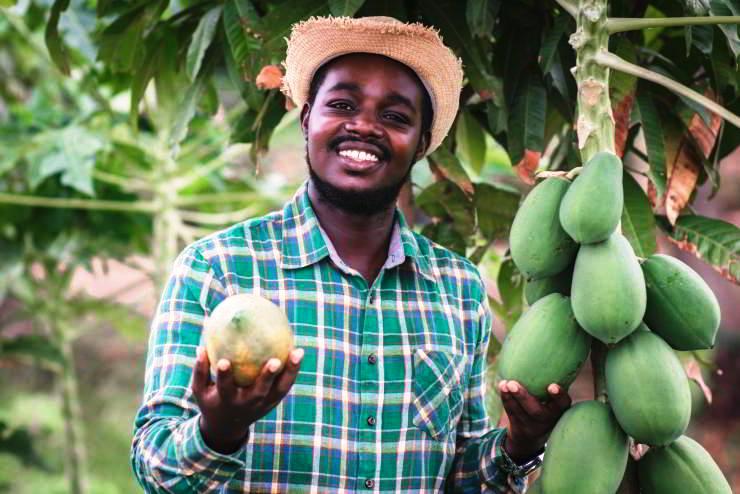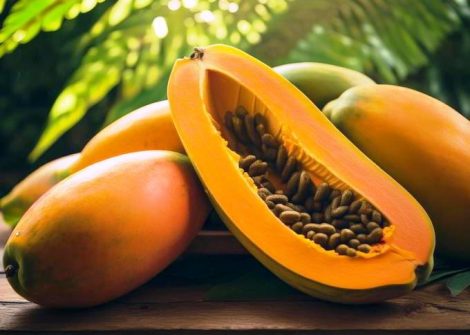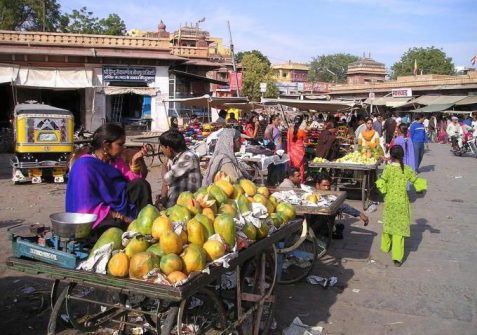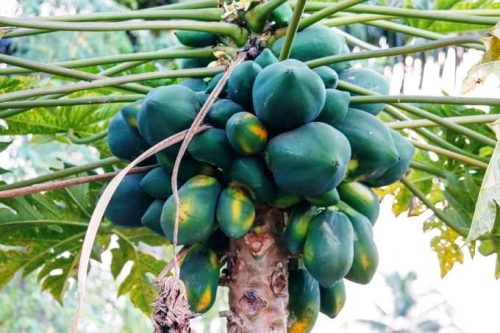Papaya. Orange-coloured richness.

Sweet, rich in properties, and relatively easy to grow. A fruit from Latin America that has found a new home in Africa. Very adaptable. Its consumption is also an indicator of good health.
Papaya is one of the most cultivated and consumed exotic fruits in the world. It grows on characteristic single-stem plants between three and ten meters tall. With green and yellow skin and orange pulp, this species of tropical melon weighs on average half a kilogram but can reach up to nine kilos. Originally from southern Mexico, European settlers introduced the papaya to Africa and India in past centuries. Historically, it was fermented to produce an alcoholic beverage, while today, thanks to its sweet flavour, almost a mix of different tropical fruits such as mango, pineapple and banana, it is used in various preparations and is a prized ingredient in desserts, jams, puddings and ice cream.

Originally from southern Mexico, European settlers introduced the papaya to Africa and India in past centuries. Pixabay
Papaya is also famous for its beneficial properties, being rich in vitamins, antioxidants, minerals and fruit acids. Papaya plants grow well in a tropical climate with high humidity and need constant water.
From the moment the seed is planted, it takes at least nine months for the first harvest, but then the trees will bear fruit all year round, ripening in 4-5 days. Although papaya production is not too difficult and has a high added value, farmers must balance often low prices with the usual overheads. To make an impact on the market, aesthetics is important, and having fruit of an adequate weight, and without imperfections, is the ideal, but this is not always possible. Usually, overripe or second-choice fruits are sent to the pressing factories or sold on the local market.
Increasing demand
However, papaya is not grown only to be consumed fresh or processed and used in the preparation of other foods. When cut, the peel of the unripe fruit releases a white liquid that coagulates quickly. An average-sized fruit provides about 100 grams of latex. This contains papain, an enzyme whose properties are similar to those of pepsin and trypsin. The digestive and dissolving action of the proteins that characterize this papaya product is used for therapeutic purposes in cosmetics, as well as in the leather and silk industries and in the production of beer.

Market. India is currently the largest producer of papaya in the world. Pixabay
Today, 13.82 million tons of papayas are produced in the world, but global production is expected to increase by 1.9 each year, up to 18 million tons in 2032.
India is currently the largest producer and Mexico is the largest exporter. The United States imports more papaya than any other country, with the European Union in second place.
According to the FAO, Africa exported 8,420 tons in 2022, including Côte d’Ivoire with 2 tons and Ghana with 595. The share of global exports is generally low compared to production: about 2.5%. Major obstacles to a significant expansion of international trade are the high perishability of the fruit and its fragility.

Peru. Papaya seller at the San Pedro market in Cusco. Pixabay
However, innovations in cold chain, packaging and transportation technologies promise to facilitate wider distribution in the future. In the meantime, the expected increase in production is mainly due to domestic demand, thanks to population and income growth. Papaya is said to thrive when the economy is good: eating it is rarely a necessity, but a choice, especially for one’s health. Those who know and appreciate its health properties are willing to pay for this fruit, which, among other qualities, is excellent for the digestive system and rich in vitamin C.
The African challenge of the organic
The growth in global demand for papaya concerns Africa because it has led to extend plantations in particularly in the Congo River basin, in the equatorial region of the continent. While the Republic of Congo (Brazzaville) is the second largest African producer after Nigeria, since 2015 the cultivation of papaya has also resumed in the neighbouring Democratic Republic of Congo. Abandoned in recent years by farmers, discouraged by the mosaic virus that had decimated the plantations, this crop is now living a second life between Kinshasa and the territory of Beni, in North Kivu, in the east of the country, and under the pressure of the government. Recently, new resistant varieties have been introduced that are giving good results and helping to improve the incomes of local producers, dragging many out of poverty. The constant insecurity in the region, due to armed groups, is however, a big unknown that risks putting the brake on new production.

Papaya is grown throughout the tropical belt of Africa, from Ghana and Benin to Mozambique in the east. Pixabay
Papaya crops extend along the entire tropical belt of Africa from Ghana to Benin to Mozambique in the east. Still, production, especially here, is also being attacked by the papaya scale insect (Paracoccus marginatus). This pest has caused a lot of damage among smallholder farmers since it first invaded the eastern part of the continent between 2015 and 2020. Research has not been idle, and the International Centre for Agriculture and Biological Sciences (Cabi) is working in collaboration with national institutions to help farmers in South Sudan, Kenya and Uganda respond to this challenge. In addition to training and prevention, the plan is to introduce a natural enemy to combat the papaya scale insect: a wasp known as Acerophagus papayae. The ultimate goal is to offer an alternative to chemical pesticides, which are more harmful to handle and have a greater impact on the environment, to control the papaya scale insect through an integrated pest management plan. The growth of production on the continent depends on this victory. (Open Photo: African farmer with holding fresh papaya in the organic plantation field. 123rf)
Tommaso Meo/Africa



